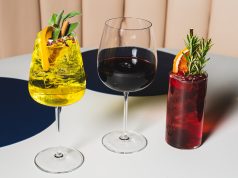
So, in math, multiplying two negatives equals a positive. However, conventional wisdom says two wrongs don’t make a right. Given that we can’t use arbitrary precedent, how do we determine if combining two food trends is good or bad?
The short answer is that we do it on a case-by-case basis. Butter coffee combined with a trendy restaurant concept (as seen in this week’s cuisine review) is good. Posting photos of avocado on toast on Instagram is bad (and also the sign of the apocalypse in Etruscan lore).
So how do we grade a combination of the much-mocked trend of pumpkin spice and the firmly at-its-peak trend of bitter liqueurs?
I say it’s good because it elevates the pumpkin spice flavor that still has merit but has been made lazy by Globo-flavor Enterprises, Inc., the fictional and shadowy conglomerate of chain restaurants and house spray companies that killed this once promising flavor superstar (also to blame are the tired jokes about white girls consuming pumpkin spice everything; it’s already dead, guys). It also elevates the bitter liqueur, which often gets reduced to brand names like Fernet or Cynar by bros at bars who for some reason take shots of this stuff instead of sipping them around meals as they were intended to be.
But the best melding of pumpkin spice and bitter drinks might come in the creation of pumpkin spice bitters. By doing so, you can concentrate the flavors that make pumpkin spice desirable, add in or segment out what you like or don’t like, and add it to any number of cocktails to add an autumnal kick.
Fortunately, it’s easy and pretty fun to make bitters. You need three ingredients: a bittering agent, alcohol and a fruit, vegetable or herb for flavor. You can do this at home in a sealable glass jar, and it’ll take about five weeks to complete.
First, you’ll need to get something that will imbue bitterness into the bitters. That sounds right. This is usually a bark or root, and by far the most common bittering agent, and most easily accessible, is gentian root. You can find it at many health food stores, ethnic groceries or, if all else fails, online. You can also use cassia bark, wormwood or certain fruit rinds or peels.
Next, you’ll need a fruit, vegetable, herb or a combination of the three for flavor. For our pumpkin spice bitters, we’ll use roasted pumpkin, cinnamon, cardamom and clove. You can add in other baking spices, fresh herbs, sweet potato or peach.
And lastly, you’ll need alcohol. Most home-made liqueur and bitter recipes call for the use of a high-proof vodka or grain liquor. You can certainly use that here, but bourbon whiskey and pumpkin are soul mates and so that’s the recommendation.
From there, you’re set. Get yourself an empty 750 mL bottle. Roast 12 ounces of cubed pumpkin meat until they’d be just about ready to eat, about 25 minutes at 400 degrees. You can drizzle a very small amount of olive oil to ensure moisture if you’re paranoid, or you can pull them out early if they start to dry up too quickly. Cool the pumpkin, and pour them into the bottle. Add in a half dozen crushed cardamom pods, a cinnamon stick or two (you can determine the flavor, and you can also put in crushed cinnamon if you have some fancy stuff), and a dozen or so cloves. Fill the rest of the bottle up with your favorite bourbon — Wild Turkey 101 or Knob Creek is recommended because they’re spicy and high in alcohol.
Shake your mixture daily and in four to five weeks, you can strain the mixture through cheesecloth or a coffee filter. For added sweetness, make some brown sugar simple syrup and add it to the mixture as desired. In subsequent batches, add and reduce ingredients to meet your taste desires. If the bitters are too bitter, you can actually age them in alcohol in a separate bottle and mix the bitter blend with the flavor blend at a later date.
When your bitters are done, you can add them to any number of cocktails — they’ll taste great in bourbon drinks like an Old Fashioned or a Boulevardier. Also, dashing them into a dark rum or even a coffee-based drink would be pretty excellent.














